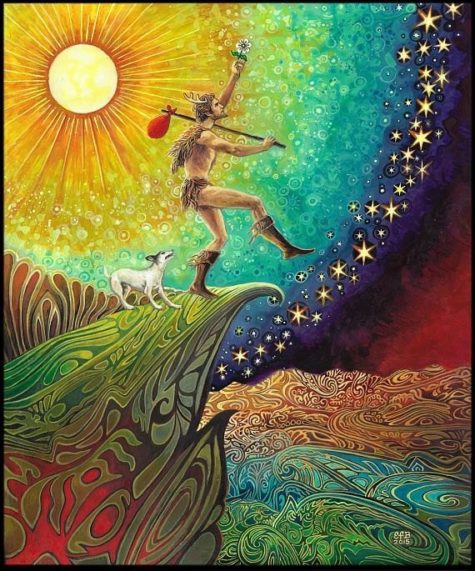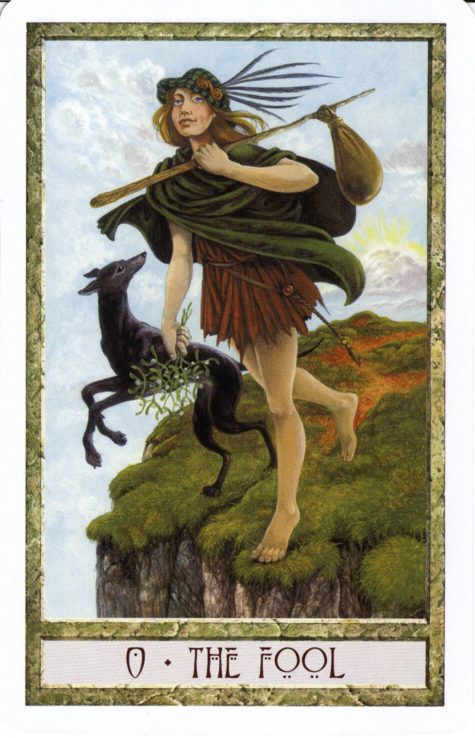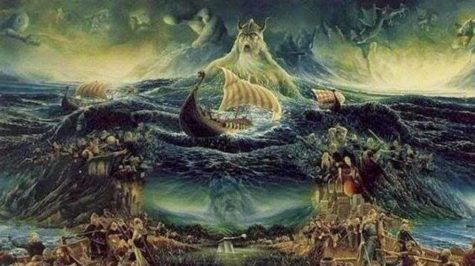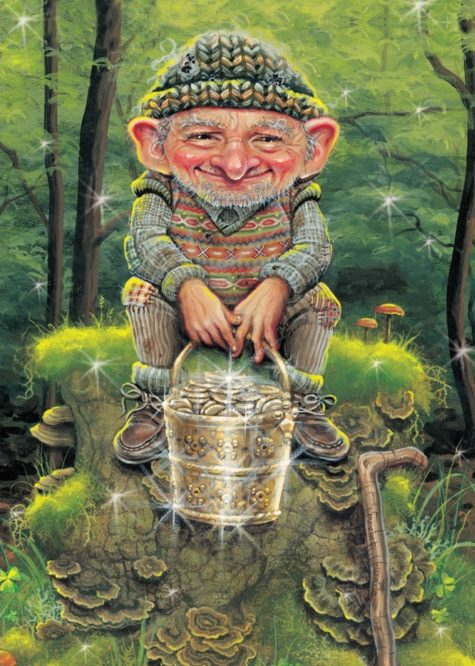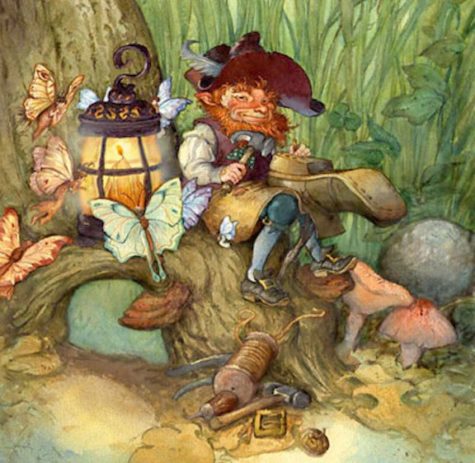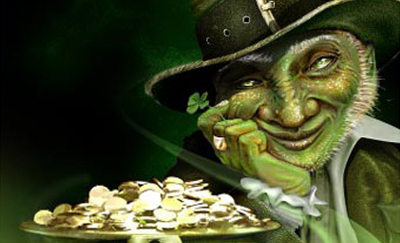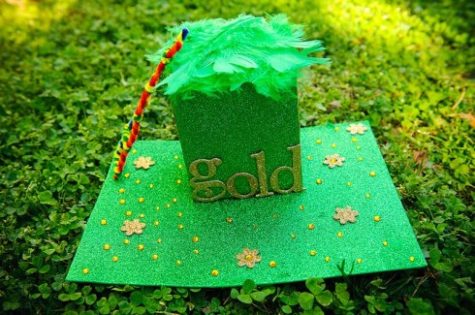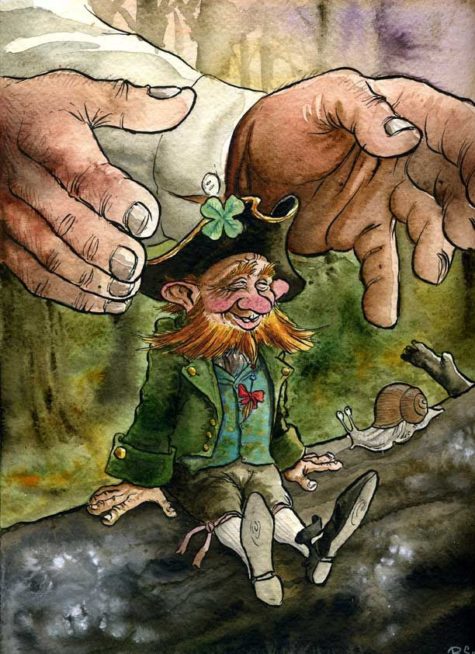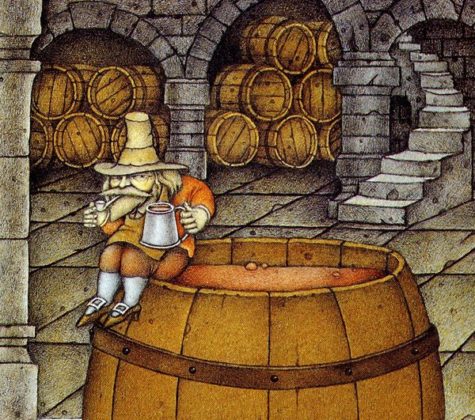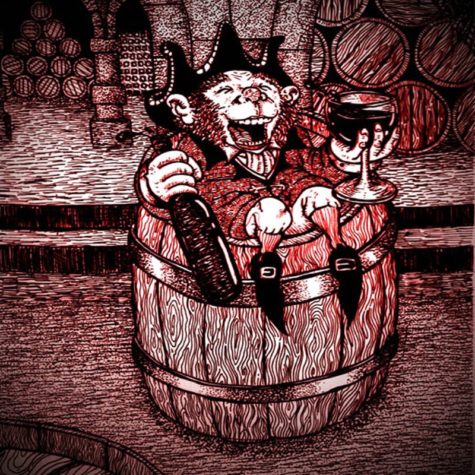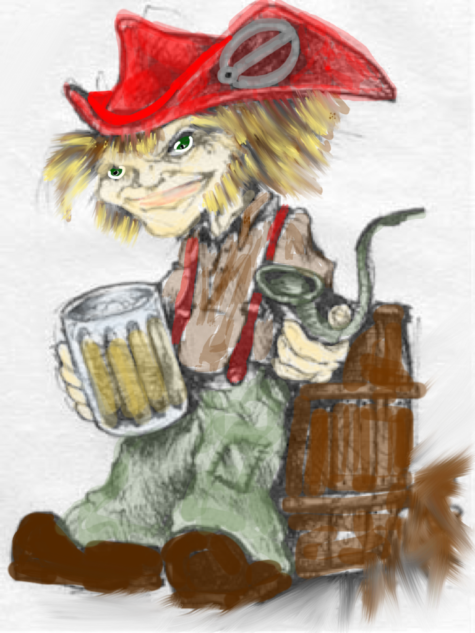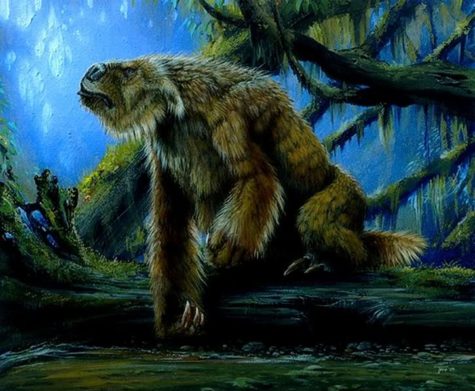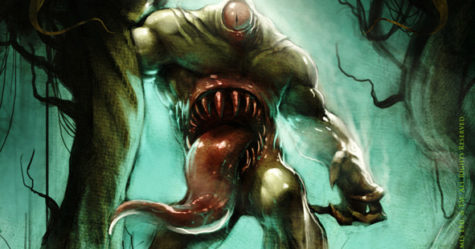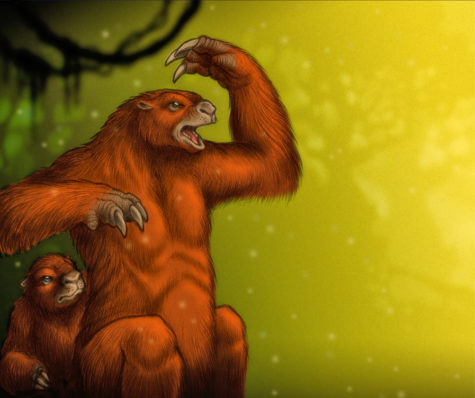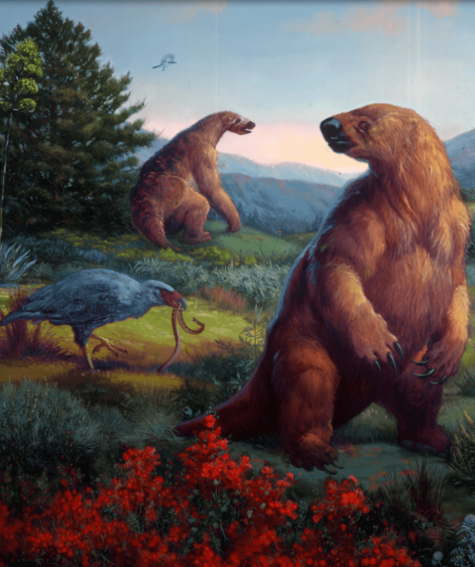Monthly Archives: March 2019
The Fool is the spirit in search of experience. He represents the mystical cleverness bereft of reason within us, the childlike ability to tune into the inner workings of the world. The sun shining behind him represents the divine nature of the Fool’s wisdom and exuberance, holy madness or ‘crazy wisdom’. On his back are all the possessions he might need. In his hand there is a flower, showing his appreciation of beauty. He is frequently accompanied by a dog, sometimes seen as his animal desires, sometimes as the call of the “real world”, nipping at his heels and distracting him. He is seemingly unconcerned that he is standing on a precipice, apparently about to step off.
Here are some key phrases that can be used to describe this card:
- entering a new phase
- striking out on a new path
- expanding horizons
- starting something new
- beginning an adventure
- going on a journey
- heading into the unknown
- being spontaneous
- living in the moment
- letting go of expectations
- doing the unexpected
- acting on impulse
- feeling uninhibited
- surprising someone
- feeling carefree
- having faith
- trusting the flow
- staying open
- letting go of worry and fear
- feeling protected and loved
- living in joy
- recapturing innocence
- believing
- embracing folly
- accepting your choices
- taking the “foolish” path
- pursuing a pipe dream
- being true to yourself
- taking a “crazy” chance
- trusting your heart’s desire
One of the keys to the card is the paradigm of the precipice, Zero and the sometimes represented oblivious Fool’s near-step into the oblivion (The Void) of the jaws of a crocodile, for example, are all mutually informing polysemy within evocations of the iconography of The Fool. The staff is the offset and complement to the void and this in many traditions represents wisdom and renunciation, e.g. ‘danda’ (Sanskrit) of a Sanyassin, ‘danda’ (Sanskrit) is also a punctuation mark with the function analogous to a ‘full-stop’ which is appropriately termed a period in American English. The Fool is both the beginning and the end, neither and otherwise, betwixt and between, liminal.
The number 0 is a perfect significator for the Fool, as it can become anything when he reaches his destination as in the sense of ‘joker’s wild’. Zero plus anything equals the same thing. Zero times anything equals zero. Zero is nothing, a lack of hard substance, and as such it may reflect a non-issue or lack of cohesiveness for the subject at hand.
In many esoteric systems of interpretation, the Fool is usually interpreted as the protagonist of a story, and the Major Arcana is the path the Fool takes through the great mysteries of life and the main human archetypes. This path is known traditionally in Tarot as the Fool´s Journey, and is frequently used to introduce the meaning of Major Arcana cards to beginners.
The conventional explanations say that The Fool signifies the flesh, the sensitive life, depicting folly at the most insensate stage. When The Fool appears in a spread, he is a signal to strip down to the irreducible core, and interrogate whether the Querant’s self-vision is obscured. It may also be a warning that significant change is coming. Another interpretation of the card is that of taking action where the circumstances are unknown, confronting one’s fears, taking risks, and so on.
From: Information collected from various sources.
What follows is an extensive listing of the Norse Gods, Goddesses, Giants, Dwarves, Spirits and other Mythical Creatures and Supernatural Beings, along with a short explanation of each.
A
- Aclis – Twin gods worshiped by the Teutons, said to be the sons of the Sky God.
- Aegir – God of the Sea (or Ocean Giant), who lived on Hlesey island. He was skilled in magic. He can be good or evil. He and Ran have nine wave daughters, or “undines”. He represents gold, prosperity, sailors, sunken treasure, brewing, control of wind and waves. Mistblindi is his father and Logi is his brother.
- Æsir, Asynur – A plural word meaning “pillars”; or “supports”; and is the collective name of the Old Norse Gods of the family of which Odin was the patriarch. The singular is Ase or Áss. Ása is used as a prefix to denote that the God or Goddess is of the Æsirî.
- Agnar – Older brother of King Geirrod, son of King Hraudung. He was lost when ten winters old on a fishing trip with his brother and, after being washed ashore, was looked after for the winter by Odin and Frigga.
- Ai – A Dwarf from the race of Lovar.
- Alaisiagae – War Goddesses. See Valkyries.
- Alf – Elf; sometimes male ancestral spirits.
- Alfar – Plural of Alf. The Elves, which are divided into three races Ljosalfar, Dokkalfar, and Svartalfar, or Light Elves, Dark Elves and Black Elves, the last also called Dwarves. All of the Alfar are wise magicians. They will frequently take an interest in individual humans, as shown by such names as Alfred (Elf-counsel), Aelfgifu (Elf-gift), and so forth The Alfar are also unpredictable, taking pleasure or offense at the slightest things; your manners and bearing are exceedingly important in dealing with these wights.
- Alfrik, Algfrig – An artistic Dwarf, a son of Mimir . With Berling, Dvalin, and Grer, he forged Freya’s incredible Brising necklace. To get the jewelry she spent one night with each of them.
- Allfather, Alföder, Alfödr – One of the titles of Odin, “The Oldest of the Gods”.
- Allsvinn – Allsvinn is one of Sun’s two horses that drags the sun (the other is Arvak). They are chased by two wolves. Allsvinn has protection-runes carved on his hoofs. Arvaker is the other horse.
- Alsvid – The horse that pulls the chariot of the moon, driven by the god Moon. Under the shoulder-blades of the horse the gods put two bellows to cool them, and in some poems that is called “iron-cold”.
- Althjof – A soil dwelling Dwarf.
- Alves, Elves – There are both Light Elves and Dark Elves. The Elves are good and have Freyr as their leader, but the Black Elves or Dwarves are evil-minded.
- Alvis – One of the wisest dwarves. He is known for demanding to marry Thrud, Thor’s daughter. Thor challenged him until the the sun rose and turned him to stone.
- Andhrimnir – Andhrimnir is the cook that slaughters the boar Saehrimnir every night. The meat is given to the hungry warriors in Valhalla. Eldhrimnir is the pot that Andhrimnir cooks in.
- Andvari – A Dwarf, a shape-shifter, who lived as a pike in a pool in Svartalfheim.
- Angrboda, Angr-boda – A Jotun-Giantess, the mother, by Loki, of horrible monster children Hel, Fenrir-wolf, and Jormungand, the Midgard serpent. She lives in Ironwood, may be related to Skadi.
- Annarr – A by-name of Odin. Also, the second husband of Night/Natt, with one daughter by her called Earth/Erda (Nerthus).
- Ari – Ari is an Eagle-Giant who frightens the dead outside Nifilhel. Nifelhel is the kingdom of the Death-Goddess Hel. Hel takes care of those who have died of age or misfortune.
- Aridva – A rock dwelling Dwarf.
- Arvak, Arvaker – One of Sun’s two horses that drags the sun’s chariot, chased by the wolves Hati and Skoll. Arvaker has protection-runes in his ear. Under the shoulder-blades of the horses the gods put bellows to cool them. Allsvinn is the other horse.
- Asa, Asa-Gods – A God of the Æsir; The Æsir; also used to refer to the Æsir and Vanir together. Ases (pl)
- Ása-Thór – Thor, the thunder god’s full name.
- Åsgardsreia – A band of superantural entities, with Odin at the helm, riding across the sky at Yuletide amidst much noise and rowdiness. See Wild Hunt.
- Askr and Embla – Origin of humanity, the first man and woman. The first man, Askr, was made from an Ash tree. His wife, Embla, was an Elm.
- Asvid, Asvido – A ruler of the Giants.The Gant who carved runes of wisdom on Yggdrasil.
- Asynjor, Asynjur – The Goddesses; feminine version of Æsir; also female attendants of Frigga in Vingolf. One of them, a healer, was called Eir. Others were named Fjorgyn, Frimia, Fimila, and Hnossa the beautiful.
- Atrid – Another name for Odin.
- Aud – Son of Nagifari and Night.
- Audhumla – The name of the mythological sacred cow–the primeval shaping force of the Cosmos, created from the moisture where the heat from Muspelheim collided with the frosty fog of Niflheim. The great cow produced Buri by licking on the salty rocks of Ginnungagap and nourished the Giant Ymir with her milk .
- Aurboda – The mountain Giantess Aurboda is Gymir’s wife. Together they have the son Beli and the daughter Gerd, a beautiful Goddess that Freyr married. Freyr had to give away his self-wielding sword to get his bride.
- Aurgelmir – The primal being. The Frost Giants’ name for Ymir.
- Aurochs -The extinct wild ox of Europe, last seen alive in 1627. Symbolized by the rune Uruz.
- Aurvandil – The friendly Giant Aurvandil is the sybil Groa’s husband. Aurvandil was the foster father of Thjalfi (Thor’s servant). On their way back from killing the Giant Hrungnir, Thor and his companions were met by a violent snowstorm and a freezing cold. Thor saved Aurvandil from a certain death and carried him over the Elivogar straits from Jotunheimur to the citadel of the Elves. During the trip Thor did not notice that one of Aurvandil’s toes was exposed. It froze, so Thor broke it off and cast it up into the heavens, where it still stands as the star called Aurvandil’s Toe.
- Austri – The Dwarf who was put in the sky’s east corner by Odin, Vili and Ve. The sky is made out of the Giant Ymir’s head. The other three dwarves were Nordri, Sudri and Vestri.
- Origin: Ireland
- Manifestation: Leprechauns are described as small wizened men wearing a shoemaker’s leather apron.
The stereotype of the Leprechaun involves lucky charms and pots of gold at the end of the rainbow. If captured by a human, they often grant three wishes in exchange for their freedom.
Leprechauns are highly commercially modified spirits; their image used to sell breakfast cereal, beer, and anything even remotely Irish. In recent years, Leprechauns, re-envisioned as “evil Fairies” have evolved into villains of horror movies; however this distorted image has no relation whatsoever to true Leprechauns who may be grouchy but are by no means vicious killers.
True Leprechauns are members of the Fairy folk, a type of sidhe. They are unusual because, in a realm dominated by females, Leprechauns are virtually exclusively male spirits.
The name Leprechaun derives from the Gaelic leigh brog “one shoemaker.” He is a cobbler, the only professional sidhe. While the other sidhe are out dancing and reveling, the Leprechaun is hard at work. He is, however, always seen working on only one shoe rather than a pair, which may be a shamanic reference.
References to shoes, especially one shoe, are often oblique references to shamanism. Ancient shamanic seances were often performed with one shoe on and one shoe off or featured dance steps that mimicked limping.
He works on shoes continually, with time off only for an occasional spree. The Leprechaun is fabulously wealthy: he buries his treasure in pots and is reputedly a skillful but not always nice practical joker. He may be invoked for financial aid.
Like other Irish fairies, Leprechauns may be derived from the Tuatha Dé Danann. Leprechaun-like creatures rarely appear in Irish mythology and only became prominent in later folklore.
- Interesting factoid: Leprechaunism is another name for Donohoe Syndrome, a rare genetic disorder characterized by delayed or diminished growth and facial features perceived as elfin.
According to Yeats, the solitary fairies, like the Leprechaun, wear red jackets, whereas the “trooping fairies” wear green. The Leprechaun’s jacket has seven rows of buttons with seven buttons to each row. On the western coast, he writes, the red jacket is covered by a frieze one, and in Ulster the creature wears a cocked hat, and when he is up to anything unusually mischievous, he leaps on to a wall and spins, balancing himself on the point of the hat with his heels in the air.
According to McAnally:
He is about three feet high, and is dressed in a little red jacket or roundabout, with red breeches buckled at the knee, gray or black stockings, and a hat, cocked in the style of a century ago, over a little, old, withered face. Round his neck is an Elizabethan ruff, and frills of lace are at his wrists. On the wild west coast, where the Atlantic winds bring almost constant rains, he dispenses with ruff and frills and wears a frieze overcoat over his pretty red suit, so that, unless on the lookout for the cocked hat, ye might pass a Leprechawn on the road and never know it’s himself that’s in it at all.
This dress could vary by region, however. In McAnally’s account there were differences between Leprechauns or Logherymans from different regions:
- The Northern Leprechaun or Logheryman wore a “military red coat and white breeches, with a broad-brimmed, high, pointed hat, on which he would sometimes stand upside down”.
- The Lurigadawne of Tipperary wore an “antique slashed jacket of red, with peaks all round and a jockey cap, also sporting a sword, which he uses as a magic wand”.
- The Luricawne of Kerry was a “fat, pursy little fellow whose jolly round face rivals in redness the cut-a-way jacket he wears, that always has seven rows of seven buttons in each row”.
- The Cluricawne of Monaghan wore “a swallow-tailed evening coat of red with green vest, white breeches, black stockings,” shiny shoes, and a “long cone hat without a brim,” sometimes used as a weapon.
In a poem entitled The Lepracaun; or, Fairy Shoemaker, 18th century Irish poet William Allingham describes the appearance of the Leprechaun as:
…A wrinkled, wizen’d, and bearded Elf,
Spectacles stuck on his pointed nose,
Silver buckles to his hose,
Leather apron — shoe in his lap…
The modern image of the Leprechaun sitting on a toadstool, having a red beard and green hat, etc. is clearly more modern invention or borrowed from other strands of European folklore. Films, television cartoons and advertising have popularized a specific image of Leprechauns which bears little resemblance to anything found in the cycles of Irish folklore. It can be considered that the popularized image of a Leprechaun is little more than a series of stereotypes based on derogatory 19th-century caricatures.
Catching A Leprechaun
Leprechaun traps are crafts made, typically in elementary school or by families with small children, to celebrate Saint Patrick’s Day. Leprechaun trapping can be compared to leaving cookies out for Santa Claus on Christmas Eve. The traps are set up the night before St. Patrick’s Day, and children awaken to discover signs that leprechauns have visited the trap.
The traps are typically made out of common household items that can be easily found or purchased. The traps are typically green and gold and feature the stereotypical leprechaun items: gold coins, rainbows, top hat and four leaf clover. A simple google search will reveal literally hundreds of DIY Leprechaun trap ideas.
According to the tradition, one must believe leprechauns are real to trap one. It is also believed that leprechauns love gold and trickery, and may steal or hide items unless captured, pleased, or scared away. Once trapped, Leprechauns may grant three wishes, and in many of the folklore stories, those lucky enough to catch one are tricked, and made foolish wishes which they lived to regret.
In most cases, children return to the trap with signs of a leprechaun visiting rather than a leprechaun itself. There might possibly be chocolate coins, and small treasures left in their bottom drawers.
If you Catch A Leprechaun
If you get lucky and manage to catch a leprechaun you need to be smarter than him or else you will be easily tricked which can have damaging results, never take your eye off him or he will vanish.
A captured leprechaun will grant you three wishes or a gold coin to bribe his way to freedom but this is when things can go terrible wrong if the wrong decisions are made.
- Use your 3 wishes wisely
Many of an Irish man who thought he could out smart an Irish leprechaun had selected the three wishes and would either go insane trying to think of what to wish for or their wishes would back fire with something bad happening.
One common story was of Seamus in County Mayo who wished to be the richest man on a tropical island. However, when his wish came true he suddenly realized that there were no shops or pubs on the island to spend his money or even people to talk with. Unfortunately Seamus became bored after a few hours on the Island and had to waste his third wish to return to Ireland. This could be how the phrase “luck of the Irish” originated from.
One of the biggest tips an Irish person can give anyone is to never listen to what the Irish leprechauns says, no matter what. The leprechauns are great mind players and will say anything to confuse you. You’ll make the wrong wishes, although he is smart he can be fooled.
- Never trust an Irish Leprechaun
Irish leprechauns are devious little creatures and will do anything to escape from man so they should never be trusted. Some say angry leprechauns are more common than a friendly one but this is very untrue as Irish leprechauns are very friendly but tend to dislike humans who always seem to chase them for wishes and pots of gold.
If you ever spot a leprechaun you may be better off to pass him by without taking notice, you can end up in more trouble than its worth if decide to chase them as the people of Ireland only know to well. Unfortunately with cities in Ireland expanding the poor wee leprechauns are being driven further underground away from man, taking their rainbows with them.
Sources:
- Encyclopedia of Spirits
- Wikipedia
- You’re Irish
Clurichauns may or may not be the same type of spirit as Leprechauns. If not, they are closely related. Like Leprechauns, Clurichans are virtually exclusively male. The Clurichaun may be the nocturnal form of the Leprechaun, out on a bender after a hard day’s work. Alternatively, some perceive Clurichauns to be Leprechauns lacking a work ethic.
Unlike hardworking, wealth-accumulating Leprechauns, Clurichauns spend all their time drinking. They are virtually always soused although they allegedly retain their good manners, unlike the reputedly sometimes surly Leprechaun. Clurichauns come out at night to drink, party and play pranks on people.
The folklorist Nicholas O’Kearney described the Clurichaun in 1855 as follows:
“ The Clobhair-ceann was another being of the same class: he was a jolly, red-faced, drunken little fellow, and was ever found in the cellars of the debauchee, Bacchus-like, astride of the wine-butt with a brimful tankard in hand, drinking and singing away merrily. Any wine cellar known to be haunted by this sprite was doomed to bring its owner to speedy ruin.”
Katharine Briggs stated that he was “a kind of buttery spirit, feasting himself in the cellars of drunkards or scaring dishonest servants who steal the wine.”
He is also described as a trickster and practical joker, and a disturber of order and quietness in a household, making noise day and night. Despite his often troublesome nature, the Clurichaun takes special care of the family to whom he has attached himself, endeavoring to protect their property and lives provided he is not interfered with. This dual nature makes him similar to the domestic hobgoblin.
Besides his love of drinking, the Clurichaun also enjoys pipe smoking, and the small disposable clay pipes known as “fairy pipes” that are often found while digging or plowing are said to belong to him. He also knows the secret of making beer from heather.
In olden days, many were butter thieves. They still like to raid the pantry.
The only occupation for which the Clurichaun displays enthusiasm is as guardian of wine and liquor cellars. The Clurichaun will protect your cellar from thieves and can allegedly prevent wine from spoiling and bottles from breaking or leaking. Simply request his presence and explicitly leave him a sample of whatever you have in stock. Leave him offerings on a regular basis lest he decide to begin serving himself. (He may anyway.)
The Clurichaun is sometimes portrayed carrying a jug of ale or wearing a leather apron with hammer in hand, whistling as he works. He also carries a magical purse (or sometimes a pewter beggars cup) with varying properties. It may contain a shilling (known as the “lucky shilling” or spre na skillenagh) that always returns to the purse no matter how often it is spent, or it may always be full of money, and for this reason mortals will often try to capture the Clurichaun . Even if he is caught he has the power to vanish if he can make his captor look away even for an instant.
He frequently carries two such purses, one containing the magic shilling and the other containing a normal copper coin, and if captured he will present the latter before vanishing. Like the Leprechaun he is sometimes said to have knowledge of hidden treasure and can be forced to reveal its location. In such instances one of his tricks is to create the illusion of multiple treasure markers so that the seeker will not know its exact whereabouts.
Clurichaun Stories
In the folktale “The Haunted Cellar”, recorded by Thomas Crofton Croker in 1825, a Clurichaun named Naggeneen haunts the wine cellar of an Irish lord, drinking everything in sight and playing frightening pranks on the servants.
He is described as a little man measuring six inches in height with a face like a withered apple. He has twinkling eyes and a nose that is red and purple from heavy drinking. He wears a red nightcap, a short leather apron, light blue stockings, and shoes with large silver buckles. When he is discovered by the master of the house, Naggeneen talks him out of moving elsewhere by implying that he would simply move with him.
Other descriptions have him wearing red like other solitary fairies.
In another tale, “Master and Man”, a young man named Billy Mac Daniel is on his way home one winter night when he is offered a glass of liquor by a Clurichaun to warm himself. He takes the drink but when he refuses to pay for it he is compelled by the Clurichaun to serve him for seven years and a day. Billy, however, is eventually able to break his servitude by invoking the blessing of God.
In this story, the Clurichaun is able to pass through keyholes to invade homes and wine cellars and can transform bog rushes into horses to be used as mounts. Clurichauns can also fly through the air on rushes similar to witches and their broomsticks.
Sources:
- Encyclopedia of Spirits
- Wikipedia
The mapinguari (“roaring animal” or “fetid beast”) is basically the bigfoot of South America. This roaring beast wanders the forests of South America, tearing down brush and trees with its powerful claws and leaving behind a trail of destruction as it looks for food.
According to native folklore the creature has a series of unnatural characteristics related to other fantastic beings of Brazilian mythology. These include the creature only having one eye, long claws, lizard-like skin, backward feet, and a second mouth on its belly. In more recent alleged eyewitness accounts, it has consistently been described as resembling either an ape or giant ground-dwelling sloth and having long arms, powerful claws that could tear apart small trees, a sloping back, reaching heights of 7 feet when standing on its hind legs, and covered in thick, matted fur.
This cryptid is described as a giant smelly beast that can stand on its feet like a grizzly, having the face of a monkey and thick fur over skin tough enough to stop a shotgun round in its tracks. Some sources have reported it sporting a second mouth in the middle of its belly, which emits a disgusting odor that leaves men dizzy, confused, and unconscious.
According to legend, it is slow but ferocious and very dangerous due to its ability to move without noise in the thick vegetation, surprising the unsuspecting locals. Accounts state that it gave off a putrid stench and emitted a frightening shriek, and that weapons such as arrows and bullets could not penetrate the Mapinguari’s alligator-like hide.
Its only known weakness is that it avoids bodies of water, which limits its movements in a region where so many rivers, brooklets and lagoons exist (especially during the rainy season). It was believed to be carnivorous, as a 1937 report from central Brazil claimed a mapinguari had gone on a three-week rampage, killing over 100 cows and ripping out the tongues from their carcasses. However, in all accounts it did not eat humans, although when it smells the presence of people it stands up on its back feet, becoming as tall as two metres, a movement similar to grizzly bears.
Often, people say the mapinguari serves as a sort of jungle protector, attacking those who take more resources than necessary. In this sense, it is similar to other legendary protector/punisher figures, like the boitatá and the curupira, a creature with backward feet who finds joy in confusing hunters.
According to Brazilian stories, the Mapinguari was once an Amazonian shaman who discovered the key to immortality thousands of years ago. He angered the gods and was severely punished as to his discovery, which forced him to be transformed into a wandering beast for the rest of his life.
Most sightings show the beast as a giant sloth, although a few see it as an ape-like creature. Most cryptozoologists speculate that the Mapinguari is either a Megatherium, a large giant ground sloth from the Ice Age that lived in the area, or another species of Giant Sloth.
There are accounts of this sort of creature that span tribal groups who have no contact with each other, and many similar stories from hunters, rubber tappers, and more. The ubiquity and consistency of these reports piqued the interest of some scientists. One, an ornithologist named Dr. David Oren, has arranged expeditions to search for the mapinguari, but so far has collected zero sightings and a bunch of hair and feces that turned out to be be the deposits of giant anteaters and the hair of small rodents.
One member of the Machiguenga tribe in Peru told another scientist, Dr. Glenn Shepard, that he had seen a mapinguari in a museum in Lima. That museum just so happens to include a display featuring a model of Megatherium.
Lucas Karitiana, a member of the Karitiana tribe in Brazil, insists his son encountered one in the forest, and, although he escaped unscathed, the whole surrounded area looked “as if a boulder had rolled through and knocked down all the trees and vines.”
Sources:
